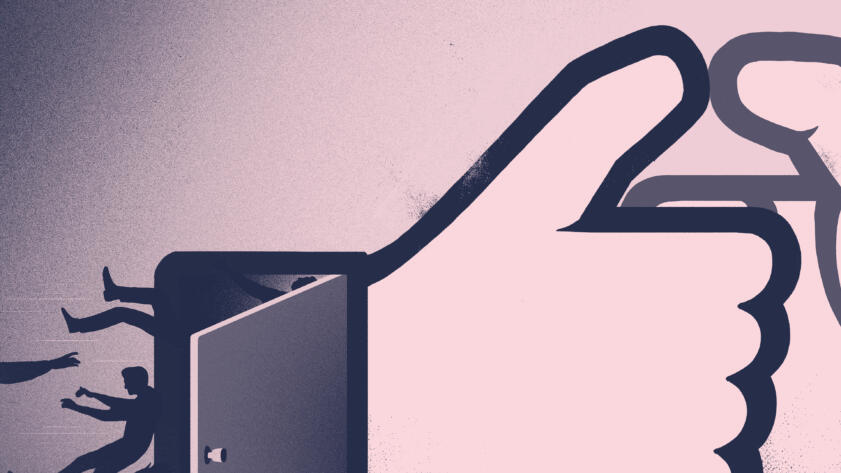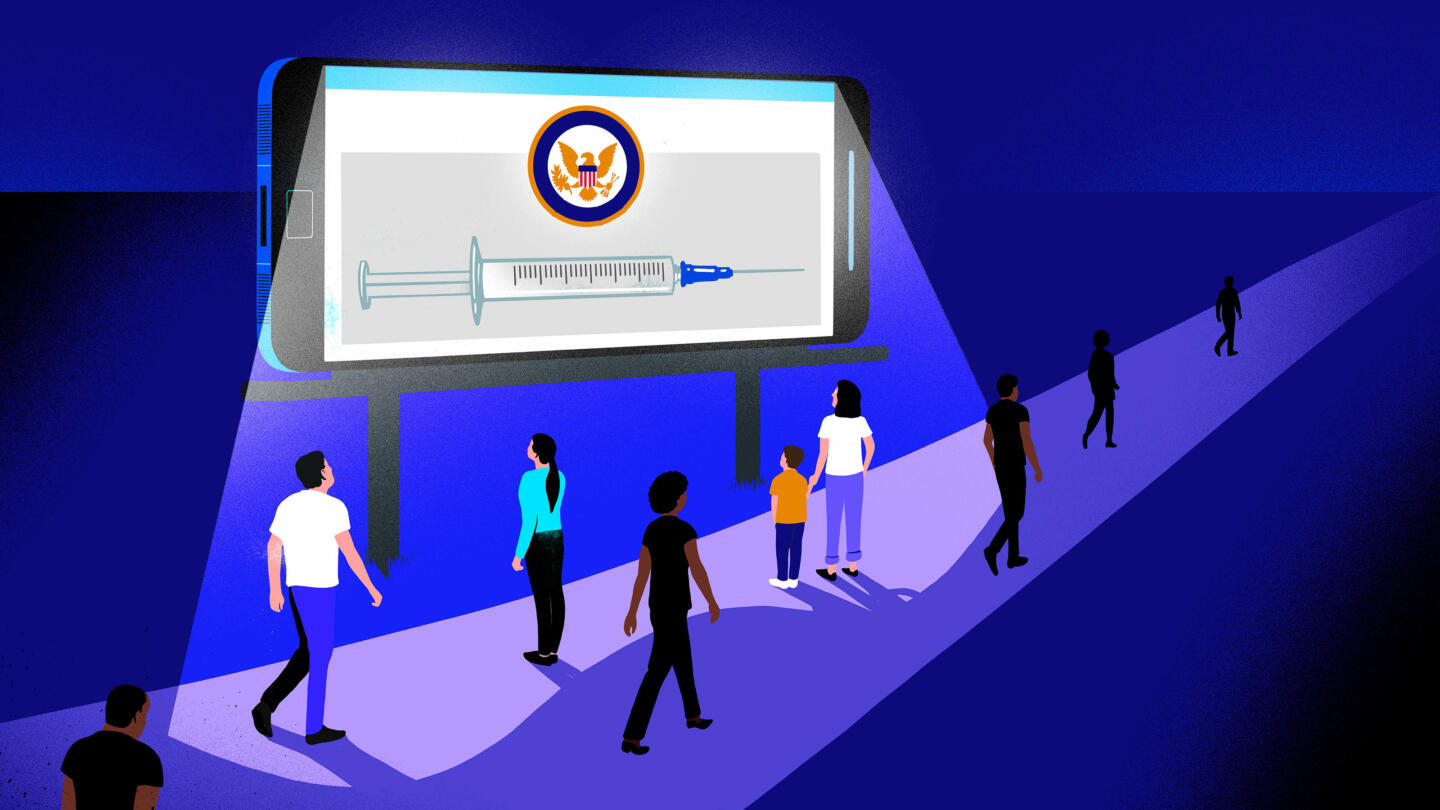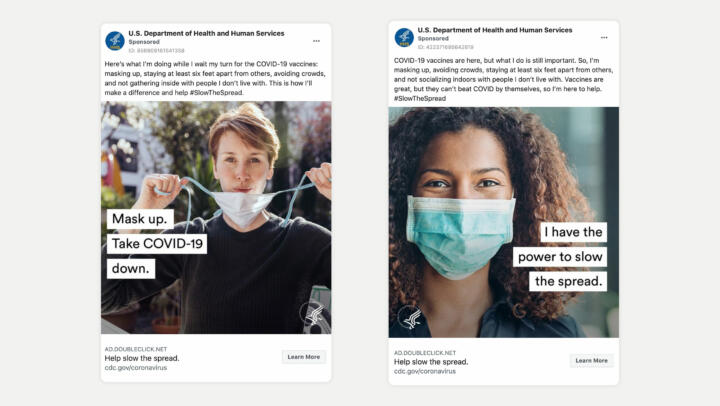Official information about COVID-19 safety and vaccines is reaching fewer Black people on Facebook than other demographic groups, according to data from The Markup’s Citizen Browser project.
The Markup’s findings come as several reports point to racial disparities in the U.S. around who has been able to get the COVID-19 vaccine. Experts cite several factors to explain the discrepancy—medical mistrust due to a history of discrimination and a lack of vaccination sites in Black neighborhoods, as well as gaps in reliable access to information on the safety of COVID-19 vaccines and how and where to get them.
Our panel consists of more than 2,500 Facebook users across the country who automatically share information about their news feeds with us. The Markup examined 4,104 sponsored posts containing COVID-19 safety and vaccine information on the platform between Dec. 1 and March 1, of which 464 came from regional, national, and international public health agencies. We included any sponsored post containing the word “vaccine,” “vaccination,” “COVID,” or “coronavirus” from a public health agency.
We found that, overall, only 3 percent of Black people on our panel were shown information from these public health agencies during this time period, compared to 6.7 percent of Latino panelists, 6.6 percent of White panelists and 9.5 percent of Asian or Asian-American panelists. None of the Native American or Middle Eastern panelists in our dataset were shown any sponsored posts on vaccination or COVID-19 safety from public health agencies, although this may be because of the low numbers of panelists in these demographic groups. Review our data here.
When it came to posts from the nation’s top public health agency, the Department of Health and Human Services (HHS), the disparity held: Only 1.5 percent of Black panelists were shown sponsored posts with information related to COVID-19 safety and vaccines, compared to 4.5 percent of White panelists. In general, minorities were shown fewer public health posts from HHS, with those posts appearing in the feeds of 1.7 percent of Latino panelists and less than one percent of Asian/Asian-American panelists. Again, no Native American or Middle Eastern panelists were shown any of the posts.
Black Facebook users saw fewer COVID-19-related PSAs than other groups
Percent of panelists shown COVID-19-related PSAs by racial group

“The Black community has been the focus of anti-vax conspiracies,” said Naomi Smith, a sociologist at Federation University Australia who studies vaccine misinformation on social media. “The fact that accurate information is being withheld from that community is very concerning.”
When asked for comment, Facebook spokesperson Dani Lever said in an email, “Given its limited number of participants, data from The Markup’s ‘Citizen Browser’ is not an accurate reflection of the full breadth of people who see ads on Facebook.” She added that Facebook doesn’t offer ad targeting based on race or use race data to show people ads.
“All advertisers must abide by our longstanding non-discrimination policy,” Lever said. “We’re focused on helping everyone access reliable information from health experts about COVID vaccines; and a big part of this effort has included helping government organizations and NGOs run free ads on our platform.”
HHS did not respond to multiple phone and email requests for comment.
Michael Lanza, a spokesperson for the NYC Department of Health and Mental Hygiene and Scott Smith, public information officer for the Minnesota Department of Health, both said their departments have taken broad steps, beyond social media, to reach minority communities with COVID-19 information.
Concerned about mounting vaccine misinformation spreading across its platform, Facebook announced last month that it would give $120 million in advertising credits to public health departments and nonprofits. Part of the idea, it said, was to “amplify” accurate information for groups that have been hardest hit by the virus and also have low vaccination rates, including Black, Latino, and Native American communities.
We chose to limit our inquiry to posts by public health departments to avoid unintentionally including fundraising or other types of posts by nonprofits that were not public service announcements.
Neither HHS nor Facebook responded to our questions about how the targeting choices were made specifically for these ads or what information Facebook gives HHS page managers about the demographics of its ad viewers. Regardless of an advertiser’s choices, Facebook’s algorithms do play a role in deciding who sees which ads.
Subscribe to the Citizen Browser Newsletter
We’re investigating what content social media platforms amplify. Sign up for updates on what we uncover.
The social media company removed ad targeting by race after a 2016 report in ProPublica that exposed discriminatory ad targeting based on “ethnic affinity.” In 2018, the Department of Housing and Urban Development sued Facebook over the company algorithm responsible for ad targeting, saying it led to housing discrimination based on race, religion, and national origin.
When asked to comment on the case, Facebook’s Lever said, “We have gone above and beyond any other digital advertising platform to prevent discrimination in ads.” She added that in 2019, Facebook “restricted targeting for ads offering housing, employment and credit in the U.S.”
HUD referred The Markup to the U.S. Department of Justice when asked about the status of the case. DOJ spokesperson Kristina Mastropasqua said, “No comment.”
There are limitations to our analysis: The Citizen Browser panel represents only a small fraction of Facebook users in the U.S. and skews older and whiter than the general population. Our panel is particularly short on Latino Facebook users, and Black, Asian, Middle Eastern and Native American Facebook users are also underrepresented compared to the U.S. population as a whole. But it provides a unique window into the choices made by Facebook’s algorithms.
Since panelists provide us with details about their age, race, and gender when they join the project, our data gives a glimpse into who is and who isn’t receiving COVID-19 PSAs that would be difficult to find elsewhere.
Fadi Quran, campaign director for Avaaz, a nonprofit advocacy group, said the findings point to a troubling pattern: Facebook’s algorithm is not putting COVID-19 and vaccine information from accurate, reliable sources into everyone’s feeds.
“It’s not a surprise that the algorithm is dumb and racist. But it’s still shocking,” Quran said. “Until we can crack open Facebook’s algorithm, we will never know how bad this problem is.”

Show Your WorkCitizen Browser
How We Built a Facebook Inspector
The Citizen Browser project seeks to illuminate the content Facebook elevates in its users’ feeds
Avaaz found in August that health misinformation on Facebook was viewed by users four times more often than accurate information from government agencies.
Many Black and Latino communities have legitimate concerns that could lead them to take a wait-and-see approach to vaccination, said Dr. Oni Blackstock, founder and executive director of Health Justice. This makes well-executed public health campaigns even more important, she added.
“If the correct person is providing the information, it could make a difference,” Blackstock said. “It’s not like people have bizarre reasons for waiting and seeing; it’s more that a lot of people don’t have the information they need, or it hasn’t been presented to them in an accessible way.”
Earlier this month, the Massachusetts Institute of Technology’s Sloan School of Management released a study, partially funded by Facebook, that found that public health PSAs showing people are getting the COVID-19 vaccine are key in combating vaccine hesitancy. That’s because when people see others getting inoculated, they’re more likely to do the same.
“It’s what social scientists call homophily, the idea that birds of a feather flock together,” said Dean Eckles, co-author of the study and an associate professor at MIT. He said people who are anti-vaccination make up a small percentage of the population, but “there’s still vaccine hesitancy, and that can be an issue when it’s clustered in certain communities.”
One of the reasons for vaccine hesitancy in the Black community is the lack of trustworthy information on social media sites, said Brandi Collins-Dexter, a visiting fellow at Harvard Kennedy School’s Shorenstein Center. In a June report, she found that the Black community had especially been left in an “information vacuum” during the pandemic—one that’s been filled with misinformation.
“Because all of this is unfolding on the ground in disproportionate ways, you’re seeing these communities particularly experience devastating consequences for un-reined misinformation,” Collins-Dexter said. “Those far-reaching stories online then become the new mythology that people latch onto.”






